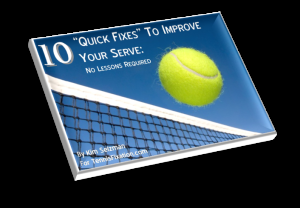Podcast: Play in new window | Download
So you think you know all about tiebreaks? What about the Coman tiebreak? Do you know how to play one of those? In this episode of Tennis Quick Tips, you'll learn exactly what a Coman tiebreak is and you'll see just how easy it is to play one. And after learning about the Coman tiebreak, you'll probably want to play one every time you have a tiebreak in a doubles match. You can listen to this episode by clicking on the media player above or by listening in with your favorite podcast app. You can also subscribe in iTunes by clicking on this link: tennisfixation.com/itunes.

SHOW NOTES:
This week I am going to tell you all about the Coman tiebreak, and this will be a short episode because, by the end of it, you'll realize the Coman tiebreak is actually pretty easy. And if you're not already playing it, you're going to wish that you were in every doubles match that you have, where a tiebreak comes up.
The Standard Tiebreak Procedure
So you may remember back in Episode 72, I did a whole episode on how to play a tiebreak in tennis, and it was pretty long because I guided you step by step through the tiebreak process, talking about the rules that apply, and how exactly you need to think about it to remember the rules when you're actually involved in a tiebreak. And I told you what to do before the tiebreak starts, during the tiebreak and after the tiebreak.
So, if you want to know exactly how to play a tiebreak, and you want a thorough explanation, go back to Episode 72. And that way you can easily either go back and read the show notes where it's really set out, or you can listen to that episode again.
But today what we're talking about is the Coman tiebreak procedure. You may have heard of this and you may not have, but it is something that you'll see more and more in league tennis as many leagues are adopting this procedure as their tiebreak procedure that they want you to play.
What is a Coman Tiebreak?
So what is a Coman tiebreak? Well, the process for it is set out in the ITF Rules of Tennis. If you look at Rule 5, Comment 5.7, that's where you'll see the Coman tiebreak first mentioned, and it refers to when to change ends of court after a tiebreak has occurred.
The Coman tiebreak procedure also comes up in Rule 10. And in Comment 10.2, they also refer to the Coman tiebreak procedure. So, let's talk about where this procedure comes from and why we have it, and exactly how it works.
The Coman tiebreak has actually been around since the 1980s, but it was only in the early parts of the 2000s that it was adopted by the USTA for national league play, here in the U.S. And since that has happened, it has become a much more wide-spread procedure to use.
What is the Difference Between a Coman Tiebreak and a Standard Tiebreak?
So, what is the difference between a Coman tiebreak and a standard tiebreak? Well, very little. The standard tiebreak procedure I'm not going to repeat that for you here, because you either you already know it, or as I said earlier, you can go back to Episode 72 to really get a thorough explanation. But the difference between a standard tiebreak and a Coman tiebreak has to do with when you change ends of court.
You may recall that in a standard tiebreak, players change ends of court after every six points. That means you're going to change ends of court after the sixth point in the tiebreak, after the twelfth point, after the eighteenth point, etc. Hopefully you won't get much past the eighteenth point, but you're going to change ends between sixth and seventh points.
So, if your score for example in the tiebreaker is 4-2, that's when you're going to change ends of court. What this means is that the server who served point six, is going to change sides of court in the middle of his or her serve. Now, if you're playing a singles match, that might not be that big of a deal, because you've already been serving from each side.
But if you're playing a doubles match, and this happens to you, that could mean that you're serving one point from a side that you've been serving on, and then you switch, and now you're serving for the first time in the tiebreak game, which is obviously a critical game, you're serving for the first time from a side that you've never served on before.
So, in doubles this switching of sides occurring in the middle of somebody's serve, can be disruptive and in fact at some point in a doubles tiebreak, you'll be serving both of your serves from a side that you haven't served on before.
In the Coman tiebreak everything is played the same, except that players switch ends after the first point and then after every four points, that's the only difference. You still go through the same process of how many serves you take, you still go through the process of which side you serve from. And again, I'm not going to repeat all that here.
The only difference when you play a Coman tiebreak is, the first server serves one point and then you switch ends and that's it. You're going to serve one point and then you're going to switch after every four points, OK? So instead of this switching between six and seven, you're going to switch after every four points.
With the Coman, You Always Serve from "Your" Side
Now, let me explain why this is a change in procedure and why it actually is a good one. In a standard tiebreak game during a doubles match, as I said previously, players end up serving from both sides of the court rather than from their quote side, from their designated side that they've been serving from, that they're used to serving from. The Coman tiebreak ensures that doubles players will always serve from their side and thus it helps provide some consistency within the set. In other words, the tiebreak serving conditions are consistent with the set serving conditions. So, for example, if you have been serving from a side where you've had the sun in your eyes as you serve, and your partner has not, you will continue to serve from that side and have the sun in your eyes. Your partner will continue to serve from the other side and not have the sun in their eyes. So, you'll have some consistency in the serving conditions and you won't find your partner, all of the sudden at a crucial time because it's a tiebreaker, suddenly having to adjust to having the sun in his or her eyes. The same thing applies to your opponents, obviously. They'll get to serve from their side and this is achieved because of the more frequent changing of sides. So, in a doubles tiebreak, using the Coman process, you'll get to always serve from your side.
With the Coman, You Don't Switch Sides in the Middle of Someone's Serve
Second, there's no changing in the middle of someone's serve. Again, while this is spread out amongst all of the players in a tiebreak, it's going to probably, to the extent it has a negative impact, negatively impact the player that it happens to for the first time. That's the player who's serving between point six and seven. It's also, supposedly, if it is a negative impact, going to negatively impact that player who gets to point twelve and thirteen, but by that time, if it is a negative thing to have to switch sides in the middle of your serve, it's already happened, and that player, and that team I should say, that had to switch sides in the middle of one of the team member's service game, they could be quite far back by that point. And so, it's kind of hard to overcome that negative thing by saying that, well the other team has to experience it too.
With the Coman, Both Teams Experience Any "Negative" Conditions Equally
Third, because the Coman tiebreak results in more frequent changes and sides, the effects of the court conditions are more fairly experienced by both players in singles or both teams in doubles. So, if there are negative conditions, like sun, wind, overhead lights in your face, those types of things, more frequently changing ends of court means that both teams, or both players will experience those effects.
So, that's all there is to the Coman tiebreak. It's just the timing and the frequency of changing ends of court. And again, you change after the first point and then after every four points.
Like tiebreaks in general, a lot of players aren't aware of this, I know, but it is one of those things that really tiebreaks are going to come up in your matches and this is an area where you should know the rules and it's best to be that player on the court who does know the rules and can authoritatively state them. And if you do play a league match, and for the first time have to go through this Coman tiebreak process, I promise you, once you do it you're going to wish that this was what all of your matches used, you're going to be very amenable to the Coman tiebreak.
So that's it for this week's Tennis Quick Tip. I feel like between Episode 72, which again was pretty extensive, and this episode, you should know pretty much everything there is to know about tiebreaks, and you should be ready to be that player out on the court who can say exactly what to do and convince everyone to just follow your lead.
I hope you'll let me know if you have any comments about this by leaving your comment below. I would love to hear from you!
RESOURCES AND LINKS FROM THIS EPISODE:
Tennis Quick Tips Podcast Episode 72 - How to Play a Tiebreak in TennisSHARE, SUBSCRIBE AND REVIEW:
Thanks so much for being a listener and friend of the Tennis Quick Tips podcast. And I hope you'll consider sharing this podcast with your friends and leaving a review of the show as it really helps it to be found by other like-minded tennis players. You can listen in, subscribe or leave a review by going to:
GET A BETTER SERVE FAST!
And if you're interested in getting a better serve - fast! - get my free ebook, 10 Quick Fixes to Improve Your Serve: No Lessons Required.

By applying the 10 simple tips to your serve that I give in this ebook, your serve can become a tool that you can use to gain control of points. It can become more powerful, more accurate, and something you're actually proud of. Just enter your email below and you'll get instant access to this free ebook as well as weekly updates with all of my best tennis tips!

© Kim Selzman 2015 All Rights Reserved

